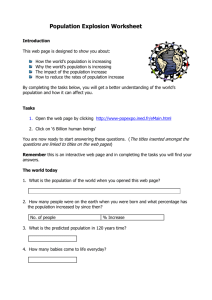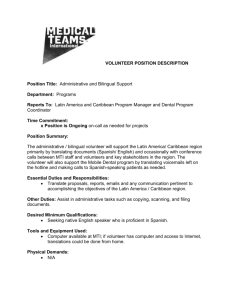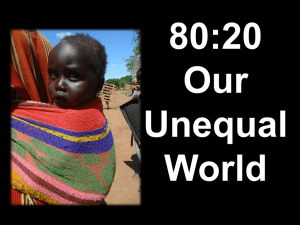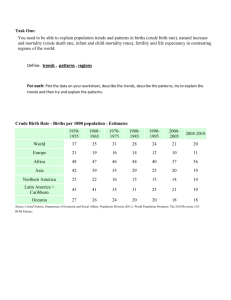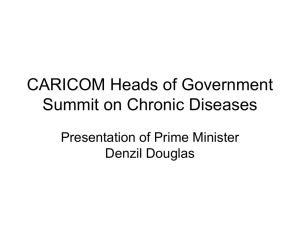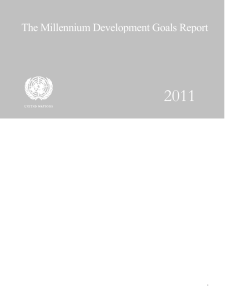Chronic diseases - London School of Hygiene & Tropical Medicine
advertisement
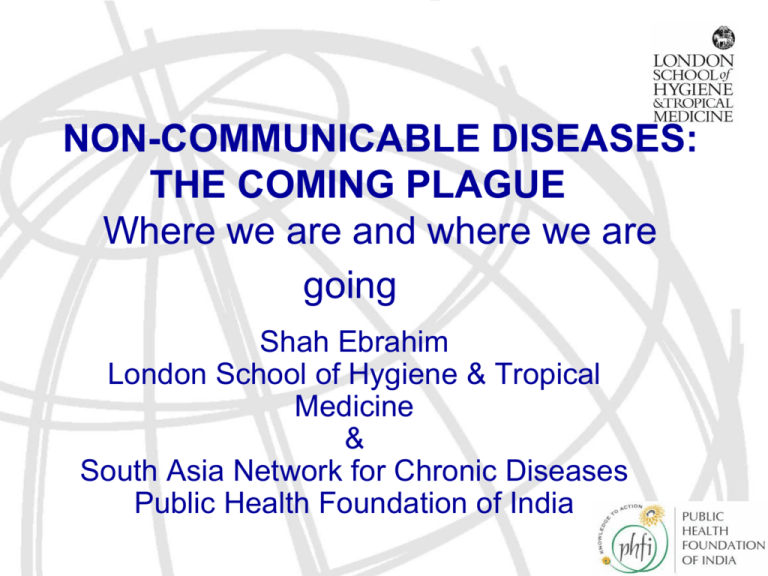
NON-COMMUNICABLE DISEASES: THE COMING PLAGUE Where we are and where we are going Shah Ebrahim London School of Hygiene & Tropical Medicine & South Asia Network for Chronic Diseases Public Health Foundation of India Where we are • Strong evidence of NCD burden • Remarkable success in MCH • An ageing population = increases in NCDs • Technical solutions but limited action • Vested interests Global Burden of Disease, 1990 EME: established market economies FSE: former socialist economies CHN: China LAC: Latin America/ Caribbean OAI: Other Asia & Islands MEC: Middle East IND: India SSA: Sub-Saharan Africa Murray C, Lopez A, Jamison D. Bull World Health Organization, 1994;72: 495-509 Global burden of disease: DALYs Low & middle income countries Lopez et al, Lancet 2006:367:1747 High income countries Rates of NCDs are higher in poorer than affluent countries Dramatic declines in child mortality - globally UN Inter-agency group on child mortality estimation. Levels and trends in child mortality, 2011 Africa Percent population 80+ years Asia Eastern Europe Latin America/Caribbean North America/Oceania Western Europe 1960 Africa Percent population 80+ years Asia Eastern Europe Latin America/Caribbean North America/Oceania Western Europe 1970 Africa Percent population 80+ years Asia Eastern Europe Latin America/Caribbean North America/Oceania Western Europe 1980 Africa Percent population 80+ years Asia Eastern Europe Latin America/Caribbean North America/Oceania Western Europe 1990 Africa Percent population 80+ years Asia Eastern Europe Latin America/Caribbean North America/Oceania Western Europe 2000 Africa Percent population 80+ years Asia Eastern Europe Latin America/Caribbean North America/Oceania Western Europe 2010 Africa Percent population 80+ years Asia Eastern Europe Latin America/Caribbean North America/Oceania Western Europe 2020 Africa Percent population 80+ years Asia Eastern Europe Latin America/Caribbean North America/Oceania Western Europe 2030 Africa Percent population 80+ years Asia Eastern Europe Latin America/Caribbean North America/Oceania Western Europe 2040 HelpAge International; www.un.org/esa/population/ageing/ageing2009chart.xls Successful maternal child health programmes result in reductions in fertility and increased life expectancy – an ageing population Lancet October 5th, 2005 World Health Organization & World Bank have emphasised need for chronic diseases in low and middle income countries to be taken seriously Many Calls to Action on NCDs... but so has everything else -Adapted from Ebrahim, Int J Epidemiol 2008 December 8th 2007 THE LANCET 8-14 December 2007 “No serious conversation about global health can now take place without at least citing chronic diseases as a critical part of international health strategies” Chronic diseases “36 million deaths from chronic diseases could be postponed by public health and primary care in the next 10 years at a cost of US$1.50 per person per year” Beaglehole, Ebrahim, Reddy et al, Lancet 2007 WHO’s 2007 strategy for low and middle income countries • Population wide: tobacco control, salt restriction (awareness, voluntary code) • High risk strategy: all those with CVD + those at high risk (1.5% annual risk of death) defined by risk factor profiles (age, sex, smoking, BP, BMI) treated with “multi-drug regimen” Tobacco: consumption and tax association in China Wang et al Lancet 2005;366: 1821-4 Salt control: voluntary code for food industry, advice to reduce salt in the home BMJ 28 June 2003 A pill to prevent 80% of heart attacks Polypill would contain a statin, three antihypertensives, folic acid and aspirin Potential impact of interventions on death rates over 10 years 16.5 million deaths prevented 13.2 million deaths not avoidable 18 million deaths prevented Population High risk Asaria et al, Lancet 2007;370:2044-2053 Not avoided The UN High Level meeting on NCDs United States, Europe, and key Western allies, blocked consensus on action on NCDs Food companies lobbying for increased LMIC markets (by Obama’s former Comms. Executive) Philip Morris – Project Sunrise – subversive operations against anti-tobacco lobby Stuckler, Basu, McKee. Commentary: UN high level meeting on non-communicable diseases: an opportunity for whom? Civil society NGOs receive funding from food, alcohol and pharmaceutical industries BMJ 2011; 343 doi: 10.1136/bmj.d5336 Bill & Melinda Gates Foundation – own 10% of global Coca Cola stock Where we are going • • • • UN High Level meeting Alliances: not disease specific silos Global Health not NCDs Getting political United Health* & NHLBI collaborating centres of excellence * “We're in the business of helping people live healthier lives” Global Alliance for Chronic Disease National Health Medical Research Council, Australia Canadian Insititutes of Health Research Chinese Academy of Medical Sciences Medical Research Council UK NIH – NHLBI & Fogarty Indian Medical Research Council - 80% of public health research funding AGA KHAN: Karachi SANCD, CCDC, PHFI Lucknow CCMB, NIN, Hyderabad SNEHA: Mumbai SANGATH Goa Inst Research & Development, Sri Lanka Wellcome Strategic Award for building research capacity for chronic diseases (£4.5 million), 2009-2013 mHealth: diabetes, hypertension, depression Population-based research ICDDR,B: Dhaka CCDC factory sites VHS: Chennai ARAVIND: Pondicherry National Family Household Survey, NSSO analyses Andhra Pradesh Children & Parents Study Genetics: COPD, DBT Policy: insurance, DfID South Asia Network for Chronic Disease, Public Health Foundation of India 35 Talking about global health Joe the Plumber says: -HIV -Hunger -Poverty -Siegel and Stuckler 2010 in preparation What do we need to do? Geneau et al Lancet 2010;376:1689-98 Political Process Model -Reframing the Debate -Create Political Opportunities -Mobilise Resources Reframing the Debate: Social Causes - Diseases of choice: victim-blaming - Diseases of affluence - ‘Us’ and ‘them’ “Isn’t obesity a sign of progress?” Personal Communication, author of World Bank World Development Report 2003 The causal chain goes from the political to the pathological Social & Economic Determinants Common risk factors Health care costs + economic productivity Common chronic diseases Failure to meet MDGs Health care costs + economic productivity Political choice: palm oil not soya oil Blood cholesterol levels Coronary heart disease increases Failure to meet MDGs Political opportunities • • • • UN High Level meeting level Older people vote Social inequalities + civil unrest Understanding the opposition Not a headline grabber... Compared with a decade ago... Buenos Aires, protest against UN High Level Meeting on NCDS ignoring older people http://www.helpage.org/newsroom/latest-news/un-meeting-on-ncds-ageing-and-dementiasnow-included/ Commission on Social Determinants of Health • Life expectancy • Infant mortality • Income • Employment • Gender • Education • Ethnicity • Health care • Social support •“India’s 12th Plan will be a health plan” Manmohan Singh, PM •Public & private sector providers •Funding 1.2% GDP up to 3% •But no role for health insurance Mobilising Resources - Advocate Global Health - Co-benefits & common cause - MDGs, climate change, early life health system - Pathways to Prevention - (eg Lazarus Effect) - Clear message - “3FOUR50”? - “Roll back Malaria” - “No health without mental health” Framework convention on tobacco control: ratified but not implemented India banned smoking in public places before England But multi-national corporates move fast... Corporate agendas for health and happiness? Who benefited here? The debate is not about priorities for child survival or cataract surgery for old men. Both young and old require a functioning primary health care service – adequate, accessible, affordable Summary • Chronic diseases are THE major cause of death and disability in most developing countries • Demographic and epidemiologic transitions are due to remarkable success stories in development • We have effective means of controlling population risk factor levels – we need to implement them • A new political process is required to achieve action focused on development for health



